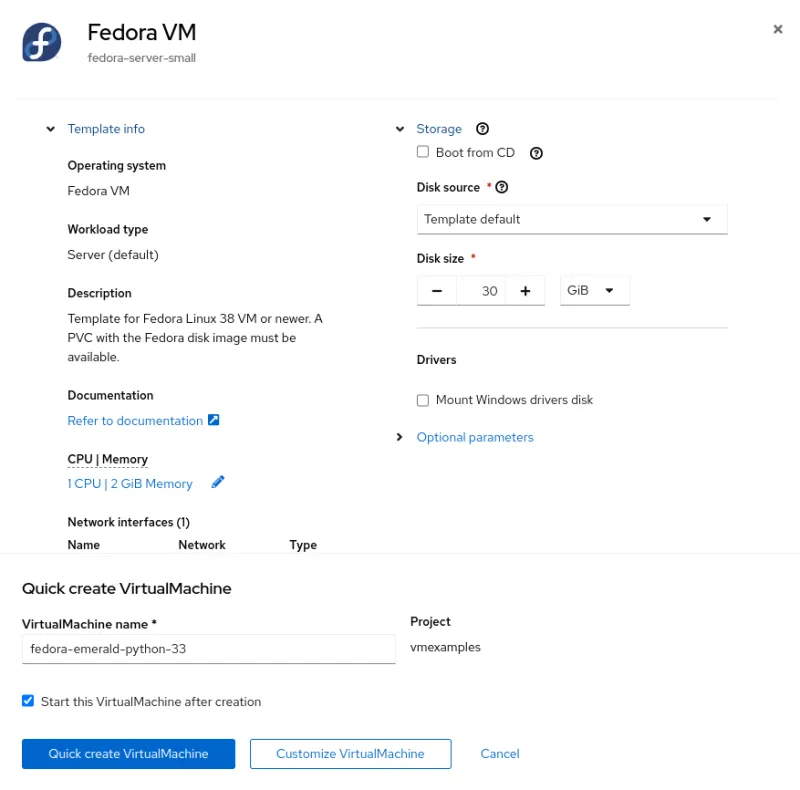Given the latest news in the virtualization market, there’s a good chance you may be searching for an alternative for your current virtual machine (VM) workloads. The good news is, Red Hat has a solution that might be what you're looking for. Red Hat OpenShift Virtualization, a feature in Red Hat OpenShift, provides a modern platform you can use to run and deploy new and existing VM workloads. It allows you to migrate and manage traditional VMs as part of your unified hybrid cloud platform.
If you’re like me, before you buy into a product, you probably want to try it out first. The OpenShift Virtualization Roadshow lets you do just that in a lab environment where OpenShift Virtualization experts will be available to answer your questions.
What is covered in the Red Hat OpenShift Virtualization lab?
Environment familiarity: This part of the lab gives you an overview of supported platforms for OpenShift Virtualization. It also helps you to familiarize yourself with the requirements to run the operator, and provides an introduction to the user interface used to manage your virtual machines.

Above shows what the OpenShift Virtualization administration would see from the overview page.
Virtual machine management: This section gives you an overview of OpenShift Virtualization fundamentals including creating a VM, modifying its allotted resources, managing its state and performing a live migration between hypervisor nodes.

The image above shows the wizard used to create virtual machines from provided templates and the options that can be customized.
Bare metal infrastructure management: When workloads increase, it’s imperative that you can scale a cluster’s physical resources in a dynamic and automated manner. We will explore adding additional nodes to our cluster on demand by scaling up our deployment using Metal3 to discover and manage additional bare metal nodes.

The image above shows the process of provisioning an additional bare metal node for when the need to scale your cluster arises.
Storage management: Red Hat OpenShift supports multiple types of storage, whether on-premises or in the cloud. OpenShift Virtualization can use any supported container storage interface (CSI) provisioner in your environment. This module will walk you through the basic concepts of storage on OpenShift, as well as how to perform other tasks related to the disk storage of the VM, such as creating and restoring a snapshot and cloning a VM.

The image above shows the process involved with cloning a VM.
Network management: VMs can be attached to the OpenShift software-defined network, which allows access from other workloads on the OpenShift cluster, including other VMs and any OpenShift-native applications. However, VMs may also connect directly to one or more external networks, such as VLANs, when needed. This module will teach you how to create a network attachment definition and connect a VM to the external network. It will also cover how to filter traffic and secure access to your VMs by implementing multi network policies.
Template management: To streamline deployment of VMs, administrators will often create templates to simplify deployment operations. We will focus on cloning existing Linux templates in the OpenShift Virtualization catalog and customizing them for specific workloads, as well as creating a new Microsoft Windows template from installation media and making it reusable for future deployments.

The built in template catalog allows for rapid deployment of virtual machines.
Migration Toolkit for Virtualization: The Migration Toolkit for Virtualization (MTV) is a feature included with OpenShift that helps simplify the migration process from other hypervisors into OpenShift Virtualization. This part of the lab will show you how to use the MTV to import a VM from your current environment into OpenShift Virtualization. You can watch a demo of importing your existing virtual machines into OpenShift Virtualization with MTV here.

A virtual application having been migrated to OpenShift Virtualization with the Migration Toolkit for Virtualization.
How can you attend a workshop?
At the 2024 Red Hat Summit in Denver, Colorado last week you may have been one of the over 200 people that were able to complete a condensed version of the workshop. If you want to attend another workshop to go more in-depth with additional topics or suggest a workshop to others, use the link below to sign up.
Whether or not you attended Red Hat Summit, however, the OpenShift Virtualization Roadshow is coming to a city near you! The roadshow features the lab that we just walked through, as well as an overview of the product offering and benefits it has to offer.
If you’re new to OpenShift Virtualization, read our e-book: 15 reasons to adopt OpenShift Virtualization. In it you'll learn how Sahibinden was able to utilize OpenShift Virtualization for their infrastructure modernization journey.
Get a comprehensive overview of the product and watch videos to delve deeper into Red Hat OpenShift Virtualization.
Red Hat is here to help you migrate and modernize your existing VM infrastructure. With Red Hat OpenShift Virtualization, your organization can modernize VM-based applications with a unified view and consistent set of tools for managing VMs, containers and serverless components consistently on-premises, on the AWS public cloud and at the edge. We look forward to seeing you at a roadshow near you.
About the authors
Courtney started at Red Hat in 2021 on the OpenShift team. With degrees in Marketing and Economics and certificates through AWS and Microsoft she is passionate about cloud computing and product marketing.
Browse by channel
Automation
The latest on IT automation for tech, teams, and environments
Artificial intelligence
Updates on the platforms that free customers to run AI workloads anywhere
Open hybrid cloud
Explore how we build a more flexible future with hybrid cloud
Security
The latest on how we reduce risks across environments and technologies
Edge computing
Updates on the platforms that simplify operations at the edge
Infrastructure
The latest on the world’s leading enterprise Linux platform
Applications
Inside our solutions to the toughest application challenges
Virtualization
The future of enterprise virtualization for your workloads on-premise or across clouds

